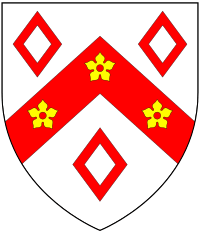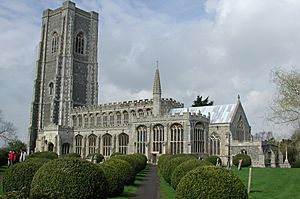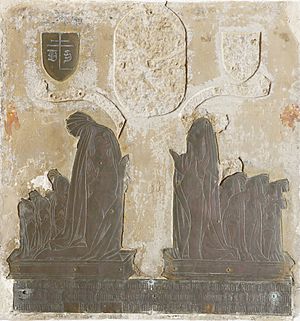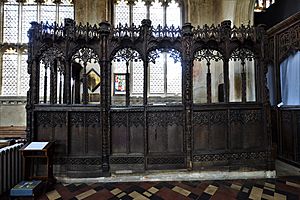Thomas Spring of Lavenham facts for kids
Quick facts for kids
Thomas Spring
|
|
|---|---|

Arms granted during the reign of King Henry VIII (1509-1547) to "Thomas Spring of Lavenham": Argent, on a chevron between three mascles gules as many cinquefoils or
|
|
| Born | c. 1474 |
| Died | 1523 |
| Burial place | Lavenham, Suffolk |
| Occupation | Cloth merchant |
| Spouse(s) |
Anne King
(m. 1493)
|
| Children |
|
| Parent(s) |
|

Thomas Spring (around 1474 – 1523) was a very successful English cloth merchant from Lavenham in Suffolk. He was also known as Thomas Spring III or The Rich Clothier. He took over his father's business and made it even bigger. During his time, the wool trade was booming, making him one of the wealthiest people in England. Many historians say he was the most important person in the cloth industry during the early Tudor period.
Contents
Who Was Thomas Spring?
Thomas Spring III was the oldest son of Thomas Spring II (who died in 1486). His mother was Margaret Appleton. You can still see a special metal plaque, called a monumental brass, for his parents in Lavenham Church.
Thomas Spring II's will, which is like a last message, mentions Thomas and his two other sons, William and James. It also mentions a daughter named Marian. Thomas Spring had another brother, John Spring. John's daughter, Margaret Spring, married Aubrey de Vere, who was the second son of a powerful noble, John de Vere, 15th Earl of Oxford.
Thomas Spring's grandfather, Thomas I Spring (who died in 1440), also had a will. It mentions his wife, Agnes, and his oldest son, Thomas (who died in 1486). It also names another son, William, and two daughters, Katherine and Dionyse.
Thomas Spring's Business Life
Thomas Spring took over his family's wool and cloth business from his father. During his lifetime, selling cloth was very profitable.
In 1502, he helped King Henry VII find people who might be planning to rebel. These people were thought to be supporting Edmund de la Pole, 3rd Duke of Suffolk. Thomas Spring traded goods through ports in Essex and Suffolk, sending them to the Low Countries (modern-day Belgium and Netherlands). In 1507, he had a legal problem because he was accused of not paying taxes on a material called alum that was brought into England secretly.
Later, in 1512, 1513, and 1517, Thomas Spring was one of the people chosen to help collect taxes in Suffolk. In 1517, during the rule of Henry VIII, Spring was excused from some public duties. This might have been because he was suspected of not paying enough taxes. At this time, he was probably at the peak of his wealth.
By the time he died, Thomas Spring was thought to be one of the richest people in England. He was especially rich in Suffolk, owning land worth more than £100 each year. In 1522, he owned valuable items worth about £1,800 and was owed over £2,200 by others. Records from 1523 show that Spring was the main landowner, or lord of the manor, for twenty-six estates in eastern England. He also owned land in more than a hundred other places.
The poet John Skelton even mentioned Thomas Spring in his poem Why come ye not to Court. Skelton's poem talks about the rich clothier and how he refused to go to court:
- "Now nothing, but pay pay with laughe and lay downe Borough, Citie and towne good Springe of Lanam must count what became of his clothe makyng. My Lordes grace will bryng down thys hye Springe and brynge it so lowe it shal not ever flow."
Just like his father, Thomas Spring was very involved in rebuilding and making St Peter and St Paul's Church in Lavenham even more beautiful. He did this partly to please John de Vere, 13th Earl of Oxford, who had also asked for the church to be rebuilt and was another big donor. This rebuilding also allowed Spring to show off his wealth and kindness. This helped him become even more important in Suffolk. Many other wool churches were built for similar reasons.
Thomas Spring's Family Life
Thomas Spring was married two times:
- His first marriage was in 1493 to Anne King from Boxford, Suffolk. They had two sons and two daughters:
- Sir John Spring (died 1547). He was the oldest son and inherited his father's property. He married Dorothy Waldegrave.
- Robert Spring (1502–1550). He wrote a will in 1547. In it, he mentioned his wife Agnes, his oldest son Thomas, and six other sons. He also mentioned two daughters, Dorothy and Frances.
- Anne Spring (1494–1528). She married Sir Thomas Jermyn from Rushbrooke in Suffolk.
- Rose Spring (born 1496). She married Thomas Guybon.
- His second marriage was to Alice Appleton (died 1538). She was a widow who had been married to a man named May. Thomas and Alice had one daughter:
- Bridget Spring (1498–around 1557). She married William Erneley first. They had two sons and two daughters. Later, she married Sir Henry Hussey.
Alice lived for fifteen years after Thomas died. In her will, written in 1538, she mentioned her daughter Bridget. She also mentioned her daughter Alice and her daughter Margaret. Alice Spring was not only a beneficiary but also helped manage her husband's will. She is said to be the last important "Spring of Lavenham." She made the second largest tax donation in Suffolk that year. Thomas, her second husband, had owned 25 estates in East Anglia. Lavenham had become the fourteenth richest town in England. The family later moved to Pakenham, and their descendants married into important families.
Death and Burial
Thomas Spring wrote his last will on June 13, 1523. He was called 'Thomas Spring of Lavenham, clothmaker'. He left his wife Alice all her clothes and jewelry. He also left her 1,000 marks in money and half of his valuable household items. The other half of these items went to John, his oldest son.
Spring also left money to his son Robert and his unmarried daughter Bridget. He left gifts to the children of his married daughter Rose Guybon and to the children of his son-in-law Thomas Jermyn. To his wife's daughter, Alice May, he left £26 13s 4d. This money was to be paid to her when she turned sixteen. He also set aside 5,000 marks to be used for future generations of the Spring family.
Thomas Spring was buried in the Church of Saint Peter and Saint Paul in Lavenham. His tomb was placed in front of the altar of St Katherine. A beautiful wooden screen, called a parclose screen, was built around his tomb. He had asked for this screen to be built in his will. His widow, Alice, hired wood carvers from Flanders to create this ten-foot-high screen. It is one of the most detailed screens still in existence today.
See also
- Spring family




